Conspiracy theories about the death of Diana, Princess of Wales do not appear to have been previously considered in an ‘information warfare’ context which is attributable to Russia. However, my recent research has uncovered a highly probable scenario of Russian co-optation and development of these conspiracy narratives as part of a strategic information campaign targeting the United Kingdom. Of course, these connections to Russian strategic information are opaque, and laundered through fronts and third parties; but the connections are top-level and obvious.
While this report will suppose that land mines play a role in the motive for disinformation attacks on Diana and her legacy, it asserts that those attacks have come from Russian strategic information interests, rather from any UK or ‘Western interest’.
As tempting as it is to wonder if Russian wetwork may be at play in this story, it is out of the scope of this report which will focus only on provable or highly likely Russian strategic conspiracy narratives and will not seek to dispute any official forensic findings of the accident investigation.
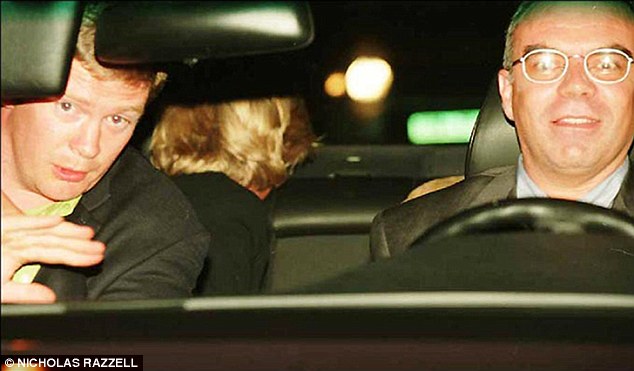
Richard Tomlinson
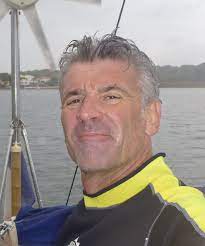
Disgraced MI6 agent Richard Tomlinson seems to be the primary purveyor of the conspiracy theory that Princess Diana was killed by rogue elements of MI6 on August 31, 1997 in a hit job which paralleled MI6 plans to assassinate Slobodan Milosevic [1].
According to intelligence historian Christopher Andrew, Tomlinson is “a pawn of Russian intelligence” whose book “The Big Breach” (2001) is a Russian foreign intelligence service (SVR) retribution for MI6’s involvement in the publication of “The Sword and the Shield: The Mitrokhin Archive and the Secret History of the KGB” (1999) which Andrew co-authored along with KGB defector Vasily Mitrokhin.
“The Big Breach” was published by the company Narodny Variant which had published no prior books, and the company representative Sergei Korovin (real name Kirill Chashchin) is a probable Russian intelligence agent, who disappeared under scrutiny [2].
The concluding chapter to “The Big Breach” (written “By the Publisher”, eg. presumably written by Korovin/Chashchin) denies any connection to Russian intelligence or that it is in any way a retribution for the Mitrokhin Archive. While the conclusion downplays any direct connection between MI6 and the death of Princess Diana, it certainly reinforces the idea that there is a parallel between MI6, Diana’s death, and plans to assassinate Slobodan Milosevic [3].
Mohammed Al Fayed
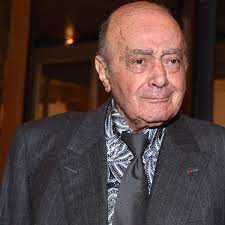
Father of Dodi Al Fayed, Mohamed Al Fayed has also been a key link to conspiracy narratives which accuse MI6, the royal family, British arms dealers, and even the Israeli Mossad of complicity in the death of Diana.
In 1998, it was reported that the Lyndon LaRouche movement and its magazine Executive Intelligence Review (EIR) were a prime source of conspiracy theories about the royal family involvement in Diana’s death. It was reported that the outlet had been previously very close to Mohamed Al Fayed, and that Al Fayed had previously used LaRouche operatives to discredit his business rivals [4].
Note that since the mid-1980’s, the US-based conservative think tank The Heritage Foundation had been covering the fascistic and anti-Semitic LaRouche movement as a potential front for Russian disinformation, noting its high level connections to Russian intelligence operatives [5].
In 1998 as well, Mohamed Al Fayed also recruited Richard Tomlinson to work for him directly, where he eventually appeared in “countless pro-conspiracy, Al Fayed-sponsored accounts of the crash” [6].
Yet another Al Fayed-funded conspiracy theory about the crash – although less attributable to Russia – was that Diana had been killed by UK arms dealers who resented her work on landmines. (To this topic we will return.) [7]
(It is also worth mentioning here the figure of Ari Ben-Menashe who has been widely criticized and paralleled to Richard Tomlinson. He also peddled false information and conspiracies about the death of Diana which he attempted to sell to Mohamed Al Fayed [8]. Ben-Menashe has been repeatedly linked to Russia over the years as a lobbyist and broker especially on behalf of African dictators.)
Ivan Grozny and Gennady Sokolov
Strange as it may appear, the next best place to link strategic Russian information warfare to the Princess Diana conspiracy theories is by way of a detour to Tsar Ivan IV of Russia (1530-1584) and the medieval printing press.
In Putin’s Russia, there has been a formal movement by Orthodox nationalist ideologists linked to the so-called “Izborsky Club” to portray Ivan IV as the victim of a 400-year-old “information war” by the West. Such ideologists have presented critical Western accounts of Ivan IV as the “first information wars” in the European press.
Russian nationalist ideological narratives that Ivan IV was the misunderstood victim of Western propaganda in a specifically “information war” context have existed since at least 2006 when they were presented in relation to the poisoning of Alexander Litvinenko, a defected Russian FSB agent living in the UK. The claims were made by professor Igor Froyanov in the hardline Russian-language publication Sovetskaya Rossiya.
However, these narratives are in fact derivative of sentiments which have been cultivated in earlier Stalinist propaganda and tsarist-era culture.
In reality, it was 16th century Russian deficiencies in printing relative to Western sources – which had a nearly 100 years head start – that was at the source of these disparities. Far from being “first”, the Western portrayals of Ivan IV echoed those of his earlier analogue, the Wallachian prince Dracula (Vlad Tepes), who was notable for his authoritarian leadership style reflected in darkly humorous allegories, such as nailing the caps of Turks to their heads who refused to remove them in his presence, or impaling Turkish soldiers [9].
There is good evidence that Ivan IV intentionally modeled his popular image in the oral folklore of Russia in alignment with Dracula stories; to include tales of cap-nailings and impalings albeit replacing Turks with equivalent Russian national enemies like Catholics or Jews [10].
Indicating that ruthlessness to women was also a part of Ivan IV’s war strategy – and again echoing Dracula – Western printing was also responsible for spreading popular imagery about Russian military cruelty to women and children in the Livonian War.
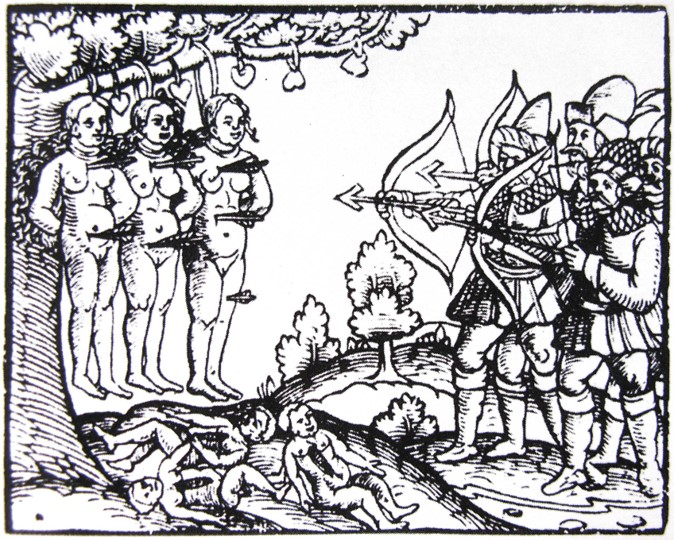
There is barely time here to mention Ivan IV’s failed overtures of marriage to his contemporary Queen Elizabeth I of England, or his plans to capture by kidnapping Princess Catherine Jagiellonka of Poland so he could forcibly marry her. We have no time to reflect on his seven “un-Orthodox” marriages, at least six of which ended in fatal poisonings or imprisonment, and all unhappily.
Echoing Froyanov on Litvinenko (and other Izborsky Club-linked ideologists beholden to the legacy of 1990s hard right church figure Metropolitan Ioann (Snychev) and his ex-Navy ghostwriter Konstantin Dushenov); in 2018 the Russian intelligence historian Gennady Sokolov claimed the poisoning of Sergei Skripal and his daughter were relatable to this same 400-year-old Russophobic smear campaign in the context of Ivan IV being waged by the West against Russia [11].
While this idea of relating a supposedly tarnished historical memory of Ivan IV to British accusations against Russia in the Skripal case was reported for how it “plumbs new depths” of disinformation , it was clearly in reality not a new idea in the aggressive Russian nationalist discourse related to information warfare and Ivan IV.
To emphasize this idea’s centrality to Russian security, the same line of reasoning about Ivan IV has been recently employed by senior figures in the Russian national security apparatus (see Nikolai Patrushev) to argue that the West is Russophobic [12]. This adoption was not overlooked by founding Izborsky Club member Alexander Prokhanov, who took credit for introducing the idea to the government elite [13]. (Note: Prokhanov had been the author of the ideological “Word to the People” article in Sovetskaya Rossiya which called for military takeover and precipitated the Communist-backed coup attempt of August 1991.)
In the subsequent months, a new Russian national security strategy has officially emerged which puts emphasis on this sort of defense of historical memory [14]. It has been noted by contemporary historians other than myself that Ivan IV is likely to fall under the purview of this new doctrine [15].
The purpose of this long detour to Russian nationalist ideologist interpretations of Ivan the Terrible in the context of “information warfare” is to demonstrate their apparently consistent ideological significance to Russian national security and strategic narratives.
Gennady Sokolov was far from the first to suggest these ideas – however, it does demonstrate his alignment with the strategic national security messaging and ideological disinformation of Russia. (He appears close to Izborskist figures like Andrei Fursov.)
https://www.youtube.com/watch?v=dbxlHKs9Spg
Also, notably in the cases of Litvinenko and Skripal, there was a very direct parallel in the ideological narratives about Ivan the Terrible as they related to contemporary Russian geopolitical conflict with the UK, specifically.
Also specifically, these cases related to poisoning murder and attempted murders widely understood and forensically proven to have been carried out by the Russian secret services.
In 2012, it was one Gennady Sokolov (who claims strong links to the Russian intelligence services) who went viral for his claims that the British espionage service MI6 was responsible for the murder of Princess Diana; calling it a “distinctively English murder”. These claims were noted for their similarity to the narratives of Mohamed Al Fayed [16]. However this seems plausible, because Sokolov himself claims to have conversed with Al Fayed via an intermediary [17].

In 2012, there was not nearly the same emphasis placed on the identification and “outing” of Russian disinformation agents in the West as had been the case in 2018.
Sokolov’s 2012 claims about a British murder of Princess Diana which mirror the reports of Tomlinson and Al Fayed deserve particular renewed scrutiny as likely strategic Russian strategic disinformation directed against the United Kingdom.
A Motive for Disinformation Against Diana?
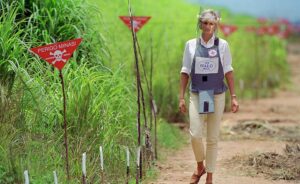
Aside from her humanitarian work on HIV-AIDS – a potential alternate avenue to examining her diametric opposition to the goals of Russian disinformation strategy – Princess Diana was famous for her support of the HALO Trust, a de-mining organization. Practicing what she preached, the Princess walked through a live mine field in Angola in January 1997, just months before she died.
It seems HALO Trust also entered Chechnya in 1997 unofficially and workers were killed by Russian rocket attacks there [18].
HALO Trust has been involved in numerous other warzones which were laid with Soviet and Russian mines. Over the years, the workers of this organization have suffered many casualties, de-mining places like Afghanistan and the legacy of the Soviet Afghan War. It is easy to see how their mission could conflict with the goals of Russian military strategy.
In 2000, three years after she died, FSB information outlets attacked HALO Trust in the press claiming that the aid workers were in fact spies connected to the UK military and were there training rebels [19].
In 2021, the remnants of the so-called Internet Research Agency are still publishing work condemning HALO Trust [20].
Of course, also in Richard Tomlinson’s book, we find dubious commentary on HALO Trust as well which links it to UK espionage, supporting the Russian allegations.
Bottom line, there is a clear record of the Russian military killing workers of HALO Trust around the time of Diana’s harrowing photo shoot for the organization, and there is a clear record of Russian strategic information services attacking HALO Trust shortly after her death, and ongoing to the present day.
Conclusion
I’m not saying the Russians killed Diana, so this isn’t a new conspiracy theory.
It can only be common sense that the Russians are objectively behind the conspiracy theories about her death however.
It may also make sense that narratives attacking free press and paparazzi in the wake of the good lady’s death also may align to the active measures of Russia.
References
[1] Angela Balakrishnan, “Pregnancy rumours, MI6 plots and Henri Paul MI6”, The Guardian, April 7 2008, https://www.theguardian.com/uk/2008/apr/07/diana.monarchy1
[2] Christopher Andrew, “Russia’s Revenge“, The Times, February 15 2001, https://web.archive.org/web/20010818023237/http://www.thetimes.co.uk/article/0,,7-85253,00.html
[3] Richard Tomlinson, “The Big Breach”, Narodny Variant, 2001, https://cryptome.org/tomlinson-mi6.htm
[4] Ambrose Evans-Pritchard, “US cult is source of theories”, The Telegraph, June 4 1998, https://web.archive.org/web/20050412210745/http://www.telegraph.co.uk/htmlContent.jhtml?html=%2Farchive%2F1998%2F06%2F04%2Fndi104.html
[5] Milton R. Copulous, “The LaRouche Network”, The Heritage Foundation, July 19 1984, https://www.heritage.org/report/the-larouche-network
[6] Martyn Gregory, “Princess Diana’s 50th Birthday: The ‘Unanswered Questions’”, The Daily Beast, July 1 2011, https://www.thedailybeast.com/princess-dianas-50th-birthday-the-unanswered-questions
[7] Martyn Gregory, “Princess Diana Death Conspiracies: Debunking the Role of Landmines “, The Daily Beast, June 6 2010, https://www.thedailybeast.com/princess-diana-death-conspiracies-debunking-the-role-of-landmines
[8] ‘The Newsroom’, “Harare treason witness in Diana fraud”, The Scotsman, July 8 2002, https://www.scotsman.com/news/world/harare-treason-witness-diana-fraud-2459502
[9] Michael Hotchkiss, “Ivan the Terrible as Pivotal Figure in the Ideology of Information Warfare”, Proceedings of the International Conference on Cyber Warfare and Security (ICCWS), 2021, https://n01r.com/wp-content/uploads/2021/02/2021-Ivan-the-Terrible-as-a-Pivotal-Figure-in-the-Ideology-of-Information-Warfare.pdf
[10] Maureen Perrie, “The Image of Ivan the Terrible in Russian Folklore”, Cambridge University Press, 1987
[11] Integrity Intitiative, ““Britain’s been attacking Russia for 400 years!”: Russian disinformation plumbs new depths in the Skripal case”, Stopfake, March 31 2018, https://www.stopfake.org/en/britain-s-been-attacking-russia-for-400-years-russian-disinformation-plumbs-new-depths-in-the-skripal-case/
[12] Vitaly Tseplyaev, ««Верим делам, а не словам». Николай Патрушев — о перспективах диалога с США» (“We believe in deeds, not words.” Nikolai Patrushev – on the prospects for dialogue with the United States), Argumenty I Fakti, April 30 2021, https://aif.ru/politics/world/verim_delam_a_ne_slovam_nikolay_patrushev_o_perspektivah_dialoga_s_ssha
[13] Masha Myers, «ОСОБОЕ МНЕНИЕ В ГОСТЯХ: Александр Проханов» (“SPECIAL OPINION with Alexander Prokhanov” (Interview)), Echo of Moscow, May 4 2021, https://echo.msk.ru/programs/personalno/2832366-echo/
[14] «Указ Президента Российской Федерации от 02.07.2021 № 400 “О Стратегии национальной безопасности Российской Федерации”» (Decree of the President of the Russian Federation of 02.07.2021 No. 400 “On the National Security Strategy of the Russian Federation”), July 3 2021, http://publication.pravo.gov.ru/Document/View/0001202107030001
[15] Dina Khapaeva, «Сажающее Средневековье» (“Sowing the Middle Ages”) , Novaya Gazeta, August 2 2021, https://novayagazeta.ru/articles/2021/08/02/sazhaiushchee-srednevekove
[16] (Grey news outlet) Will Stewart, “What was MI6 team doing in Paris the night Princess Diana died?”, Express, December 30 2012, https://www.express.co.uk/news/uk/367713/What-was-MI6-team-doing-in-Paris-the-night-Princess-Diana-died
[17] Evgeny Chernikh, «под колпаком у англичан» (“under the hood of the British”), Komsomolskaya Pravda, March 31 2013, https://www.kp.ru/daily/26054/2965694/
[18] Patrick Tyler, “Russians Say Anti-Mine Group Aids Rebels”, The New York Times, August 11 2000, https://www.nytimes.com/library/world/europe/081100russia-chechnya.html
[19] Sergey Grigoriev, «“гуманитарное разминирование” оборачивается террором» (““Humanitarian Mining ”turns to terror”), August 18 2000, (insecure web site) www.fsb.ru/fsb/smi/overview/single.htm%21id%3D10342394%40fsbSmi%26_print%3Dtrue.html
[20] Internet Research Agency, «Почему гуманитарных саперов HALO Trust обвиняют в шпионаже» (“Why HALO Trust humanitarian sappers are accused of espionage”), RIAFAN, March 17 2021, https://riafan.ru/1406318-pochemu-gumanitarnykh-saperov-halo-trust-obvinyayut-v-shpionazhe
